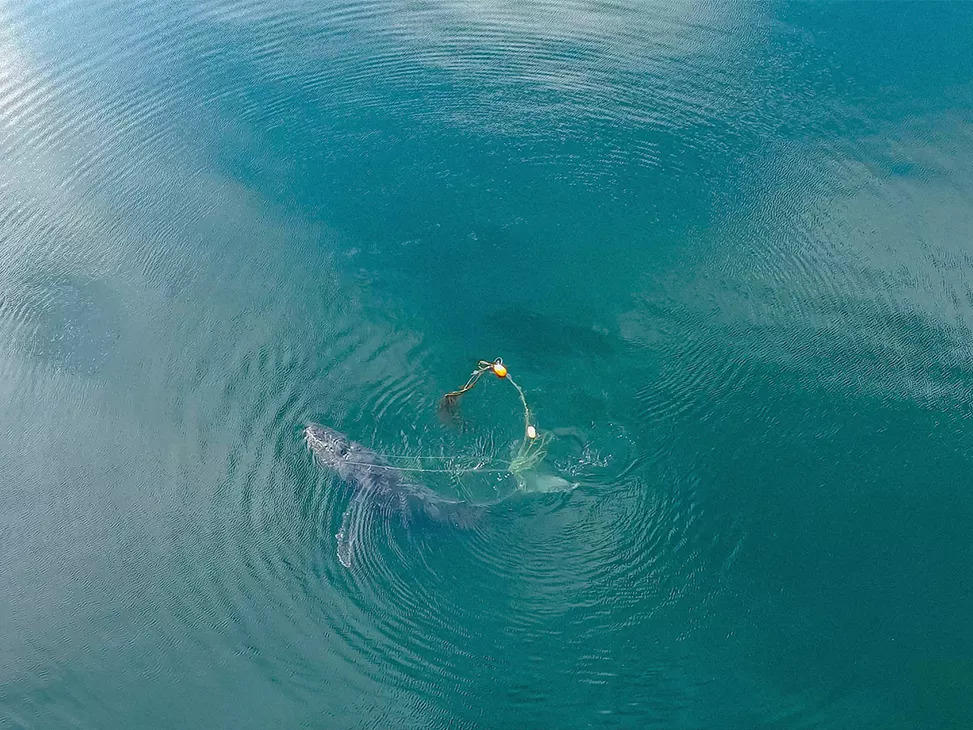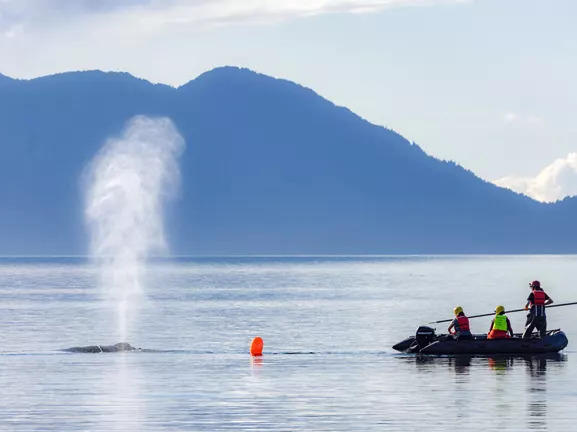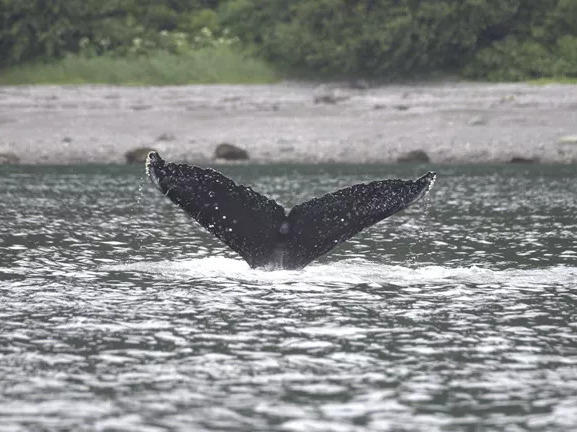Section Branding
Header Content
How wildlife officials saved a humpback whale found 'hogtied' to a 300-pound crab pot
Primary Content
Wildlife officials successfully rescued a humpback whale after it was discovered entangled in a web of crabbing gear and at risk of dying, the National Park Service said.
A pair of residents first spotted the whale on Oct. 10 off the coast of Gustavus, Alaska. Surrounded by Glacier Bay National Park, Gustavus is bordered by the so-called "Icy Strait," a popular ocean feeding ground for humpback whales in the spring, summer and fall.
But this particular whale wasn't feeding. It was seen "trailing two buoys, making unusual sounds and having trouble moving freely," according to an account of the rescue from the park service.
"In a sense, the whale was hogtied"
When park staff were able to assess the situation from a boat, they found a heavy fishing line winding from the whale's mouth to its tail, ending in a glob of tangled lines at its tail.
"In a sense, the whale was hogtied," said Janet Neilson, a whale biologist with the NPS.
"It was curved into a C-shaped posture. The line was so tight that it couldn't swim in a straight line," she told NPR.
Neilson and her colleagues called the owners of the crabbing gear, who confirmed that a 300-pound crab pot had gone missing, along with 450 feet of heavy line. The whale had likely been entangled for about three days.
In general, humpback whales get entangled more often than people realize, Neilson said.
"Usually they can get out of the gear pretty quickly on their own, just by breaching and shaking loose with energetic behaviors."
But the longer time passes, the more likely the whale is to panic, rolling and twisting until those entanglements become messier and increasingly life threatening.
In those cases when human intervention could save a whale's life, one agency authorizes a rescue operation: the National Oceanic and Atmospheric Administration's Marine Mammal Health and Stranding Response Program.
How do you untangle a 35-ton marine mammal? With a lot of patience
NOAA had a team of trained experts assembled by the following morning.
In a stroke of good luck, a few of the rescuers were able to spot the whale and its trailing buoys while flying in from Juneau, Alaska. The animal had managed to travel about a mile from where it was spotted the day before.
Neilson joined two other rescuers in a small boat while three others monitored and advised from a bigger research vessel nearby. A seventh person stood onshore to operate a drone camera, providing a bird's eye view of the coiled whale. The team analyzed those images with the help of experts as far away as Hawaii.
The sea was calm and the sky sunny, but the forecast for the coming days contained gale-force winds, adding another layer of pressure to the puzzle.
At first, the whale tried to evade the rescuers, mustering its energy to shimmy away from the approaching boat.
But with the crew's persistence, the whale calmed and acquiesced, allowing the team to start chipping away at the lines with long-handled cutting equipment, freeing the animal bit-by-bit as it surfaced for 30 second chunks in roughly nine minute intervals.
Some seven hours later, with daylight fading, the crew cut the last line — a rope wrapped around the whale's tail.
The rescuers cheered, Neilson said, but it wasn't exactly the dramatic moment you might imagine.
"On social media, there's stories of whales acknowledging [disentangle crews] in some way or breaching as a way of saying thanks, but that's not exactly what happens," she said.
The victory didn't sink in until the whale disappeared from the crew's sight.
"That meant the whale was free and probably wanted nothing more to do with us," she said. "It just bolted."
The crab pot, on the other hand, fell to the seafloor. It hasn't been recovered, NOAA reported.
Researchers were able to identify the whale as a young, Glacier Bay newcomer
Back on shore the following day, Neilson plugged photos of the rescue into HappyWhale, a website that uses image processing algorithms to match photos of a whale's tail with images contributed from previous sightings.
The website identified the whale as SEAK-5490.
Researchers think the whale is relatively new to the Glacier Bay area. The animal was first spotted in the region in July after having previously been seen in Frederick Sound, some 100 miles south.
SEAK-5490 is believed to be the same whale that a marine biologist measured about a year ago. At 32 feet long, Neilson expects it to be about 3 or 4 years old — that's quite young, given the average lifespan of a humpback whale is 80 to 90 years.
SEAK-5490 also has a scar on its back, which was likely caused by being hit by a boat's propeller in a previous incident, the NPS reported.
Both Glacier Bay park staff and NOAA personnel plan to keep a close eye on HappyWhale's sightings trackers.
"We're really, really hoping we see 5490 in our waters again, but it's possible he or she will pop up again elsewhere through confirmed sightings," Neilson said.
A word of warning: leave whale disentanglements to the experts
But while she's hopeful this story will have a happy ending, Neilson offers a word of caution for anyone eager to be part of their own.
If you come across a tangled whale, "don't do what social media tells you to do, which is jump in and try to be a hero with a knife in your hand," she said.
It should go without saying, given their size, but whales can be extremely dangerous to humans. And humans can be extremely dangerous to whales.
Some people have the impulse to cut away the heavy buoys trailing the whale, NOAA said, but that can actually make it worse — lethal lines may still be intact while the whale itself becomes harder for rescue teams to locate.
Instead, you should keep a distance of at least 100 yards and call the U.S. Coast Guard or your local NOAA marine life hotline.
You might not get a whale of a tale out of it, but, wildlife officials say, you could save some important marine life.
Copyright 2023 NPR. To see more, visit https://www.npr.org.



